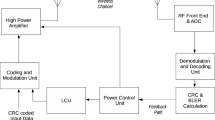Abstract
Link Adaptation is a radio resource management technique that assesses the channel conditions and selects a transport mode, from a set of possible options, which is optimised for these conditions according to a predefined criterion. The optimum transport mode is commonly determined so as to maximise the throughput. Although this approach may be appropriate for best-effort services, its suitability for multimedia services, usually characterised by tight delay and error performance constraints, has been questioned. As a result, a number of alternative algorithms have been proposed in the literature. In this context, this paper presents and evaluates in a dynamic radio environment several Link Adaptation algorithms designed to enhance the provision of delay- and error-sensitive multimedia packet-data services over wireless systems. The obtained results demonstrate that significant improvements in terms of throughput, transmission delay, error performance and operation of Link Adaptation itself can be obtained with the proposed schemes.






Similar content being viewed by others
Notes
Expression (3) assumes that transport modes with lower index i values (the minimum value is equal to 1) correspond to more robust transport modes.
A RLC block is received with the optimal CS if the used CS selected by the LA algorithm in the previous updating period is equal to the optimal one according to the instantaneous channel quality conditions experienced during the RLC block reception.
References
Barford, P., & Crovella, M. (1998). Generating representative web workloads for network and server performance evaluation. In Proceedings of the ACM SIGMETRICS Joint International Conference and Measurement and Modeling of Computer Systems, June 1998 (pp. 151–160).
Dunlop, J., Cosimini, P., Graham, G., & Le-Strat, E. (1994). Estimation of the performance of an adaptive air interface in mobile radio. In Proceedings of the RACE Mobile Telecommunications Workshop, May 1994 (pp. 47–51).
ETSI-SMG. (1997). EDGE feasibility study, Work item 184; Improved data rates through optimized modulation. Tdoc 97-331 (December).
Fabri, S., Cellatoglu, A., & Kondoz, A. (1999). Transmission of multimedia services over GPRS using MPEG-4 coded video. In Proceedings of the IEEE Vehicular Technology Conference, September 1999 (pp. 401–405).
Furuskär, A., Mazur, S., Müller, F., & Olofsson, H. (1999). EDGE: Enhanced data rates for GSM and TDMA/136 evolution. IEEE Personal Communications, 6(3), 56–66. doi:10.1109/98.772978.
Gozalvez, J., & Dunlop, J. (2000). On the effect of correlation in multislot link layer analysis for GPRS. In Proceedings of the IEEE Vehicular Technology Conference, September 2000 (pp. 444–450).
Gozalvez, J., & Dunlop, J. (2003). On the importance of using appropriate link-to-system level interfaces for the study of link adaptation. In Proceedings of the IST Mobile & Wireless Communications Summit, June 2003 (pp. 441–445).
Gozalvez, J., & Dunlop, J. (2004). Link level modelling techniques for analysing the configuration of link adaptation algorithms in mobile radio networks. In Proceedings of European Wireless, February 2004 (pp. 325–330).
Gozalvez, J., & Dunlop, J. (2005). System performance and adaptive configuration of link adaptation techniques in packet-switched cellular radio networks. The International Journal of Computer and Telecommunications Networking, 49(3), 404–426.
Hanzo, L., Cherriman, P., & Streit, J. (2001). Wireless video communications: Second to third generation systems and beyond. NY: IEEE Press.
Ho, J., Zhu, Y., & Madhavapeddy, S. (1999). Throughput and buffer analysis for GSM general packet radio service (GPRS). In Proceedings of the IEEE Wireless Communications and Networking Conference, September 1999 (pp. 1427–1431).
Kodikara, C., Fabri, S. N., & Kondoz, A. M. (2002). Performance improvement for real-time video communications by link adaptation in E-GPRS networks. In Proceedings of the Third International Conference on 3G Mobile Communication Technologies, May 2002 (pp. 489–494).
Lazaro, O., Girma, D., & Dunlop, J. (2004). H.263 video traffic modelling for low bit rate communications. In Proceedings of the IEEE Personal, Indoor and Mobile Radio Communications Conference, September 2004 (pp. 2124–2128).
Leung, K. K., Driessen, P. F., Chawla, K., & Qiu, X. (2001). Link adaptation and power control for streaming services in EGPRS wireless networks. IEEE Journal on Selected Areas in Communications, 19(10), 2029–2039. doi:10.1109/49.957316.
Luo, W., Balachandran, K., Nanda, S., & Chang, K. (2000). Packet size dependent link adaptation for wireless packet data. In Proceedings of IEEE Globecom, November 2000 (pp. 53–56).
Nakamura, M., Awad, Y., & Vadgama, S. (2002). Adaptive control of link adaptation for high speed downlink packet access (HSDPA) in W-CDMA. In Proceedings of the International Symposium on Wireless Personal Multimedia Communications, October 2002 (pp. 382–386).
Parkvall, S., Dahlman, E., Frenger, P., Beming, P., & Persson, M. (2001). The evolution of WCDMA towards higher speed downlink packet data access. In Proceedings of the IEEE Vehicular Technology Conference, May 2001 (pp. 2287–2291).
Queseth, O., Gessler, F., & Frodigh, M. (1999). Algorithms for link adaptation in GPRS. In Proceedings of the IEEE Vehicular Technology Conference, May 1999 (pp. 943–947).
Quiao, D., Choi, S., & Shin, K. G. (2002). Goodput analysis and link adaptation for IEEE 802.11a wireless LANs. IEEE Transactions on Mobile Computing, 1(4), 278–292. doi:10.1109/TMC.2002.1175541.
Ramachandran, S., Bostian, C. W., & Midkiff, S. F. (2005). A link adaptation algorithm for IEEE 802.16. In Proceedings of the IEEE Wireless Communications and Networking Conference, March 2005 (pp. 1466–1471).
Acknowledgements
This work has been supported by the Ministry of Education and Science (Spain) and FEDER funds under the project TEC2005-08211-C02-02 and by the Generalitat Valenciana under the projects GV05/189 and ACOMP07/256.
Author information
Authors and Affiliations
Corresponding authors
Rights and permissions
About this article
Cite this article
López-Benítez, M., Gozálvez, J. Link adaptation algorithms for improved delivery of delay- and error-sensitive packet-data services over wireless networks. Wireless Netw 16, 593–606 (2010). https://doi.org/10.1007/s11276-008-0156-8
Published:
Issue Date:
DOI: https://doi.org/10.1007/s11276-008-0156-8




